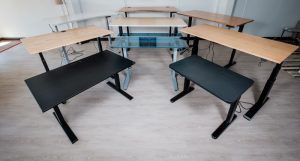Good Workplace Ergonomics Matter! Lessons from Medical Lab Technicians
Are the bad ergonomics of your workplace causing you chronic back or neck pain? If so, you’re not alone. Work-related musculoskeletal disorders (WRMSDs) are one of the leading causes of occupational injuries and disability throughout the world. In the United States, WRMSDs cause over 647,000 days of lost work every year and result in workman’s compensation claims costing anywhere from $45 billion to $60 billion. They also account for 34% of all work-related injuries and illnesses. Examples of WRMSDs include chronic back and neck pain, carpal tunnel syndrome, sprains, and hernias. While you might assume that these types of injuries are the result of unrelated incidents or isolated situations playing out in many different environments across the country on any given day, there is actually a pattern. Many of them are caused by badly designed workplaces.
This pattern became evident in a study recently published in the Journal of Back and Musculoskeletal Rehabilitation. The researchers wanted to analyze the postures of workers in a high-tech medical laboratory to determine the prevalence of work-related musculoskeletal disorders and to investigate the relationship of these musculoskeletal disorders to workers’ individual factors, their work characteristics, and their working postures.
They gathered data from the medical lab technicians, using the Nordic Musculoskeletal Questionnaire (NMQ, a standardized scale for measuring musculoskeletal disorders and occupational health), the Visual Analogue Scale (VAS, a type of self-reporting measurement), and RULA (Rapid Upper Limb Assessment, a self-reported scale by which workers assess the postures that most accurately reflect their working positions). They then assessed the positions that the technicians’ lab workstations and equipment forced them to adopt for long periods of time each day and compared them with the technicians’ medical problems.
What they found was that poor lab workstation design was causing musculoskeletal problems in 73.3% of the workers. The poorer their posture was on the VAS and RULA scales, the more musculoskeletal problems they had. In addition, there was a significant difference between pre-work and post-shift reports of neck, lower back, and knee pain. In summation, the workplace design was definitely causing the WRMSDs.
There is a very real possibility that your own workplace is just as likely to put you at an increased risk of developing musculoskeletal disorders. Symptoms of WRMSDs are not limited to back and neck pain—they also include joint discomfort, muscle tightening and swelling, stiffness, and feelings of numbness or “pins and needles.”
If you or your fellow workers have noticed such symptoms, you should report them to your employer and expect that they will take steps to correct any problem-causing ergonomics. In the interim, you can take some steps on your own to protect yourself from WRMSDs. You don’t have to sit at a desk that is too high or low or in a chair that puts you in an uncomfortable and unhealthy position. Modern desks and their accompanying desk chairs have controls that can be used to lower or raise them. The same applies to computers or other equipment you use every day—you can put your monitor on top of some books so that it’s more in your line of sight or make other changes to help make your workspace more ergonomic. A good place to start looking for tips on how to improve the ergonomics of your office workspace is the Occupational Safety & Health Administration Computer Workstations guide. OSHA also has similar guides for other types of work environments.

 We recently posted about standing desks. For those of you who are looking for some good information on standing desks, today we are sharing a review on some standing desks. Standing desks are a great option where they are allowed! Standing desks can be of great benefit by allowing greater circulation while you are working at your desk! Wonderful for those of us who spend a considerable amount of time sitting at a desk!
We recently posted about standing desks. For those of you who are looking for some good information on standing desks, today we are sharing a review on some standing desks. Standing desks are a great option where they are allowed! Standing desks can be of great benefit by allowing greater circulation while you are working at your desk! Wonderful for those of us who spend a considerable amount of time sitting at a desk!